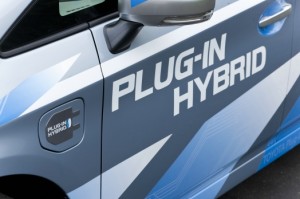 By John Addison reporting from the LA Auto Show (12/4/09, updated 12/15/09)
By John Addison reporting from the LA Auto Show (12/4/09, updated 12/15/09)
Electric cars and hybrid cars are prominent here at the LA Auto Show. GM highlighted big plans for the Chevy Volt. Toyota, owning some 65 percent of the U.S. hybrid market, displayed the Prius Plug-in Hybrid Vehicle (PHV) along with a growing family Toyota and Lexus hybrids. The Volt will have triple the electric range of the PHV. Toyota may have a $10,000 price advantage over the Volt.
For extended driving, the Toyota plug-in will normally blend power from the 1.8L gasoline engine and from the 60kW electric motor, just as the Prius does now. The Volt, however, is powered purely with its electric drive system, with a one liter gasoline engine configured in series to act as a generator. Although series designs have been used for years, GM insists that the Volt is in a unique category – the extended range electric vehicle (EREV). What may be unique is consumer confusion. Clean Fleet Report refers to both the Volt and Prius Plug-in as plug-in hybrids.
In 2010, Toyota will put 500 PHV into fleet tests with car sharing services, corporate and government fleets, and some individuals; 150 will be in the United States. At first glance, these PHV look identical to the 2010 Prius. The Prius Plug-in however use lithium-ion batteries instead of the NiMH batteries of the Prius. The PHV can travel 14 miles in electric range at up to 60 miles per hour. The Prius Plug-in 5kWh Panasonic lithium-ion batteries can be recharged in 1.5 hours with 220 volts. Three different pack configurations will be tested.
The Volt will have a 40 mile electric range; triple that of the Prius Plug-in. The Volt has a 16kWh battery pack being jointly developed by GM with LG Chem. A 220 volt recharge may take 4 hours. GM 16 kWh hours may add $10,000 to the vehicle cost over Toyota’s 5 kWh hours. Neither automaker has announced sale prices or lease rates.
Both automakers will first emphasize the California market. Most of the nation’s 40,000 electric vehicles are now on the road in California, a state with zero-emission vehicle mandates and greenhouse gas cap-and-trade being implemented.
GM has produced 80 Volt prototypes so far. In late 2010, Chevrolet starts taking orders for the Volt. In his keynote speech, GM Vice Chairman Bob Lutz estimated 2011 Volt deliveries at 8,000. Early in 2011, 400 Volts will be put into 2 year tests similar to GM’s successful Project Driveway that placed 100 Equinox Fuel Cell vehicles. Four utility partners will deploy 100 Volts each: Southern California Edison, Sacramento Public Utility District, Pacific Gas and Electric, and the Electric Power Research Institute. In parallel with these tests will be dealer sales to consumers and fleets.
These utilities and EPRI have worked closely with automakers to establish the new smart charging standard J1772. They have tested V2G, which will someday allow customers to sell power from the vehicle batteries at peak hours. All utilities have expressed interest in repurposing the lithium batteries in utility applications after 10 years of use in autos.
Plug-in hybrids will more aggressively use batteries than hybrids. Bob Lutz expressed confidence in a 10 year life for Volt batteries; he said the will use an 80/30 charge discharge cycle.
Premium Hybrids
The initial plug-in market share battle will extend up and down the product line of both automakers. Lexus currently offers four hybrid models; two have such good fuel economy that they are part of the Clean Fleet Report Top 10 Hybrids.
In the luxury model, GM may offer the Cadillac Converj plug-in hybrid to leapfrog Lexus. Converj is a concept car with breathtaking design; it has attracted cars at auto shows. The roomy luxury coupe would utilize the Volt drive system.
As competition gets interesting between Toyota and GM, they will have dozens of competitors to worry about. Nissan is actively promoting its battery-electric Leaf. Ford will be offering several models of battery-electric and plug-in hybrid.
What is Next?
Jim Lentz, TMS president, said, “Toyota’s hybrid leadership will continue to expand in the U.S. and around the globe. With 10 new hybrid models between now and 2012 in various global markets, we plan to sell one million gas-electric hybrids per year, worldwide, sometime early in the next decade.”
Toyota has announced that it wants all of its cars to have a hybrid option by 2020. Ford wants the hybrid option for 90 percent of its cars much sooner. Competition will force Toyota to keep moving forward.
Toyota will start volume manufacturing of the Plug-in Prius in 2011. 2012 manufacturing of 20,000 to 30,000 Prius Plug-ins are expected. Toyota has not yet finalized pricing. With only a 5kWh battery, Toyota will significantly under price the Chevy Volt.
In 2012, Toyota will also start selling the less expensive 2-door FT-EV, a pure battery electric vehicle. This little car will probably be similar to the IQ concept car that it has shown for a few years. In the U.S. in 2012 Toyota will face intense EV competition with Nissan, Ford, and dozens of innovative younger companies such as Tesla.
The customer will be the winner in the battle for electric car market share.

Very informative article John. I agree with your point about the how GM is trying to put the Volt in its own category of extended range electric vehicle (EREV.) I don’t think this alphabet soup game will help the consumers at all. Like you said, it’s a plug-in hybrid. As far as I’m concerned, the main drive differences between these plug-in hybrids are how big the engines are and how much capacity their batteries have, thus their electric-only range.